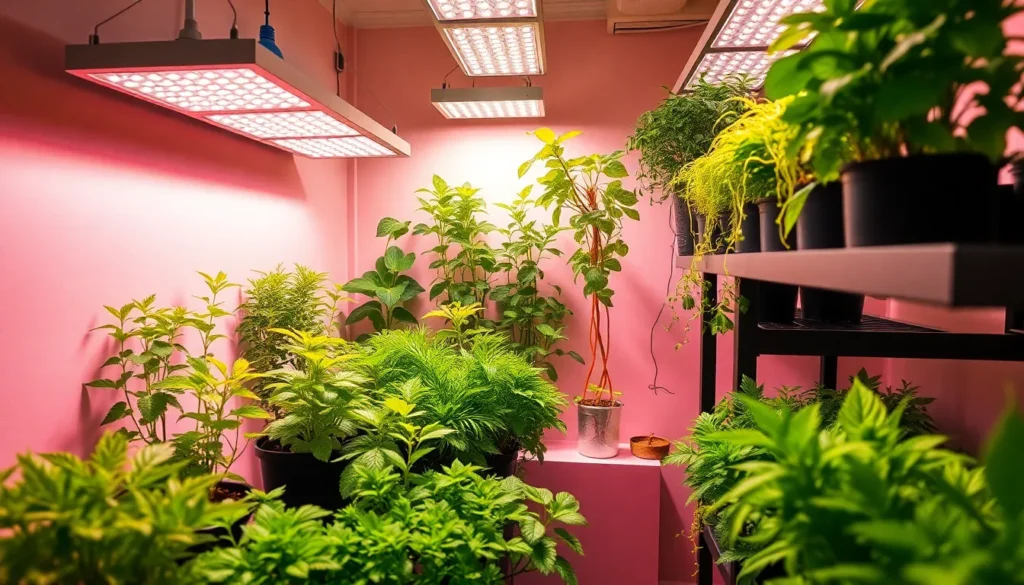Growing plants indoors doesn’t have to be a challenge when you’ve got the right grow lights on your side. We’ve all been there – watching our favorite houseplants struggle in dimly lit rooms or trying to start seedlings during those gloomy winter months. The secret to thriving indoor gardens lies in understanding how artificial lighting can replicate the sun’s powerful energy.
Modern grow lights have revolutionized the way we approach indoor gardening. Whether you’re nurturing delicate seedlings, maintaining a lush herb garden in your kitchen, or cultivating exotic plants that demand exact light conditions, the right lighting system makes all the difference. We’re seeing incredible advances in LED technology that deliver outstanding results while keeping energy costs manageable.
The best part? You don’t need to be a lighting expert to choose the perfect grow lights for your plants. With so many options available, from full-spectrum LEDs to specialized flowering lights, there’s a solution that’ll transform your indoor growing experience and help your plants flourish year-round.
Understanding the Basics of Grow Lights for Plants
Building on the foundation of modern LED technology, we’ll explore the fundamental concepts that make grow lights essential for thriving indoor gardens.
What Are Grow Lights and How Do They Work
Grow lights are artificial lighting systems designed to emit exact wavelengths of light that plants need for photosynthesis and healthy development. These specialized fixtures replace or supplement natural sunlight by producing electromagnetic radiation in the photosynthetically active radiation (PAR) range of 400-700 nanometers.
Plants absorb light energy through chlorophyll and other pigments in their leaves, converting this energy into chemical compounds through photosynthesis. Modern grow lights achieve this by using various technologies including LED chips, fluorescent tubes, or high-intensity discharge bulbs that target exact color spectrums.
LED grow lights work by passing electrical current through semiconductor materials that emit photons at predetermined wavelengths. Different LED chips produce different colors, allowing manufacturers to create custom light spectrums that optimize plant growth for exact species or growth stages.
Benefits of Using Grow Lights for Indoor Gardening
Enhanced control over growing conditions represents the primary advantage of using grow lights in indoor gardening setups. We can provide consistent lighting schedules regardless of weather conditions, seasonal changes, or geographic location limitations.
Faster plant growth occurs when we supply optimal light intensity and duration throughout the year. Studies show that plants grown under quality LED grow lights can develop 25-50% faster than those relying solely on natural light in indoor environments.
Extended growing seasons become possible as grow lights eliminate the constraints of shorter winter days and reduced sunlight availability. We can maintain productive gardens year-round, harvesting fresh produce even during traditionally dormant months.
Energy efficiency improvements make modern grow lights cost-effective answers for long-term indoor gardening projects. LED systems consume 50-80% less electricity than traditional lighting while producing less heat and lasting 25,000-50,000 hours.
Space optimization allows us to grow plants in previously unusable areas such as basements, closets, or rooms without windows. Grow lights enable vertical farming techniques and multi-tier growing systems that maximize harvest yields in limited spaces.
Key Light Spectrum Requirements for Plant Growth
Blue light wavelengths between 400-500 nanometers promote vegetative growth, encouraging strong stems, compact foliage, and robust root development. Plants require blue spectrum lighting during their early growth phases and throughout leafy green production.
Red light in the 600-700 nanometer range triggers flowering and fruiting processes in most plant species. This spectrum becomes crucial during reproductive stages when plants transition from vegetative growth to bloom and fruit production.
Full spectrum lighting that includes both blue and red wavelengths plus green, yellow, and far-red components provides comprehensive nutrition for plant development. Modern LED grow lights often combine multiple spectrum ranges to support all growth phases simultaneously.
Green light wavelengths around 500-600 nanometers penetrate deeper into plant canopies than blue or red light, supporting photosynthesis in lower leaves and interior plant structures. While plants reflect most green light, they still use approximately 10-15% for metabolic processes.
Photosynthetic photon flux density (PPFD) measurements between 200-800 μmol/m²/s suit most indoor plants, with leafy greens requiring lower levels and fruiting plants needing higher intensities. We adjust PPFD levels based on plant species, growth stage, and desired outcomes for optimal results.
Choosing the Right Type of Grow Light Technology
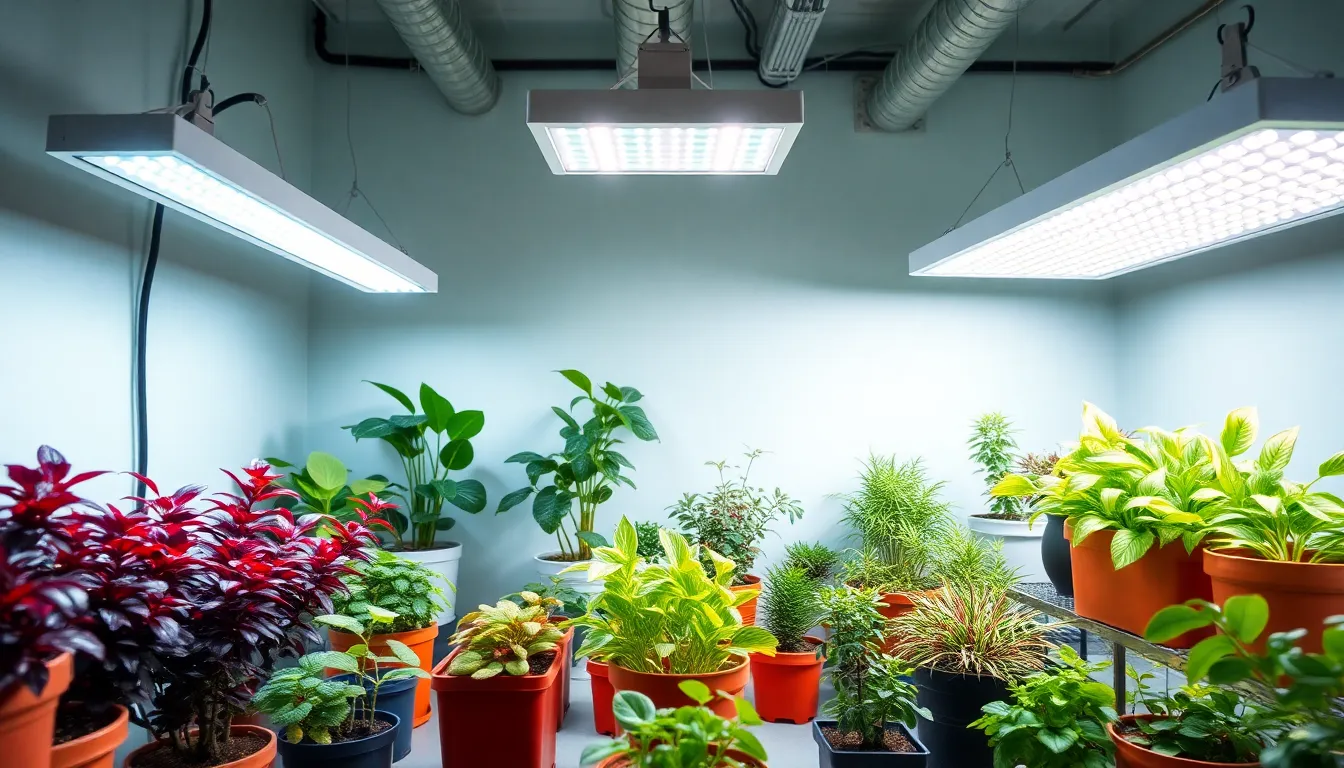
We’ll explore the three main grow light technologies to help you make an well-informed choice based on your exact indoor gardening needs and budget.
LED Grow Lights: Energy Efficiency and Longevity
LED grow lights deliver exceptional energy efficiency, consuming at least twice less electricity than HID lights and approximately three times less than fluorescent options. This superior efficiency translates to important cost savings over time, typically paying for their higher upfront investment within 18 months of operation.
Longevity stands as another major advantage of LED technology, with these lights lasting considerably longer than traditional alternatives while producing minimal heat output. Lower heat generation reduces the need for additional cooling systems, further decreasing operational costs and creating a more stable growing environment.
Spectrum control capabilities make LED grow lights particularly versatile for plant cultivation. Most models offer full spectrum lighting that can be customized to exact plant requirements, providing blue wavelengths for vegetative growth and red wavelengths for flowering stages. VOLT Grow® represents one example of high quality LED options that deliver excellent value for indoor gardeners.
Fluorescent Grow Lights: Budget-Friendly Options
Fluorescent grow lights, especially compact fluorescent lamps (CFLs), provide an affordable entry point for beginning indoor gardeners or those managing small growing spaces. These lights are readily available and require minimal upfront investment compared to other grow light technologies.
Light quality from fluorescent fixtures tends to be gentler and more suitable for seedlings and plants that thrive in lower light conditions. But, they generally produce lower light intensity than both LED and HID alternatives, which may limit their effectiveness for light hungry plants or larger growing operations.
Efficiency considerations reveal that fluorescent lights consume more energy than LEDs and require more frequent replacements due to shorter lifespans. These factors contribute to higher long term operational costs even though the lower initial purchase price.
HID Grow Lights: High-Intensity Discharge Answers
HID grow lights cover three primary types: High Pressure Sodium (HPS), Metal Halide (MH), and Ceramic Metal Halide (CMH) bulbs, each designed for different aspects of plant growth. These powerful lighting systems deliver very high light intensity, making them particularly beneficial for larger scale or commercial growing operations that require strong light penetration.
Spectrum characteristics vary significantly among HID types, with MH bulbs emitting bluish light ideal for vegetative growth phases, while HPS bulbs produce reddish wavelengths better suited for flowering stages. CMH bulbs offer a more balanced full spectrum approach that supports overall plant development throughout various growth phases.
Efficiency rankings among HID options show HPS lights leading in lumens per watt output, followed by CMH and MH technologies respectively. Even though this efficiency, all HID lights generate substantial heat and consume more electricity compared to LED alternatives, resulting in increased cooling requirements and higher energy costs for growers.
Determining the Perfect Light Spectrum for Your Plants
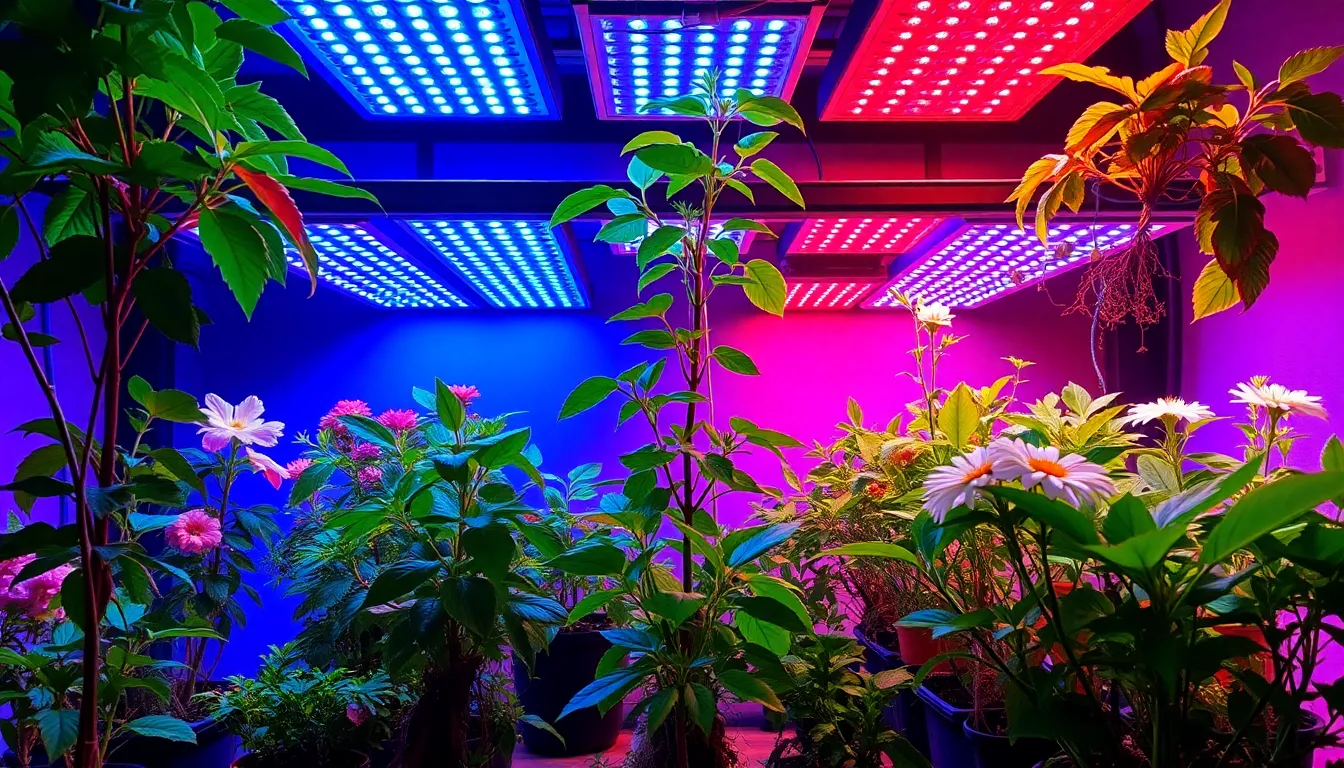
Plants primarily use blue (400–500 nm) and red light (600–700 nm) for photosynthesis and key physiological processes. Blue light promotes vegetative traits like compact growth and strong root development, while red light stimulates flowering and fruiting stages. Green light and other wavelengths support overall plant health by complementing photosynthesis and plant signaling systems.
Full Spectrum Grow Lights for All Growth Stages
Full spectrum grow lights mimic natural sunlight by delivering a broad range of wavelengths including blue, red, and green light. These lights allow us to customize “light recipes” throughout the plant life cycle to optimize development and maximize yields. Adjusting the ratio of blue to red light as needed at each stage produces healthier plants with improved structural and reproductive performance.
We can tailor light recipes based on exact growth phases:
| Growth Stage | Blue Light (%) | Red Light (%) | Additional Notes |
|---|---|---|---|
| Seedling | ~60% (450–490 nm) | 40% (630–660 nm) | Focus on blue light for strong root development; 100–300 µmol/m²/s intensity; 5000K–6500K color temp |
| Vegetative Growth | 40% blue, 40% red, 20% green | Balanced blue and red mix | Promotes robust leaf growth; PPFD around 400–600 µmol/m²/s |
| Flowering & Fruiting | 20–30% blue | 60–70% red | Enhances flower formation; 600–900 PPFD; may add far-red (730–740 nm) |
UV light (280–315 nm) during late flowering can boost terpene production, improving aroma and flavor in aromatic plants.
Blue Light Spectrum for Vegetative Growth
Blue light (400–500 nm) drives photosynthesis and encourages leaf expansion during vegetative stages. Plants exposed to sufficient blue light develop compact, healthy foliage while avoiding the leggy growth common under low blue conditions. Light color temperatures around 5000K to 6500K work best for seedlings and early vegetative development.
Strong root systems and sturdy stems result from adequate blue light exposure during these critical growth phases. We recommend maintaining higher blue light percentages (around 60%) during seedling stages to establish robust plant structure from the beginning.
Red Light Spectrum for Flowering and Fruiting
Red light (600–700 nm) triggers flowering and fruit development in most plant species. Increasing red light percentage during flowering signals plants to transition from vegetative to reproductive phases effectively. Using 60–70% red in the spectrum enhances flower bud formation and accelerates fruit maturation processes.
Far red light (730–740 nm) can further accelerate flowering in short day plants when added at the end of each light cycle. This wavelength helps plants recognize day length changes and promotes faster flowering responses in light sensitive varieties.
Calculating the Optimal Light Intensity and Coverage
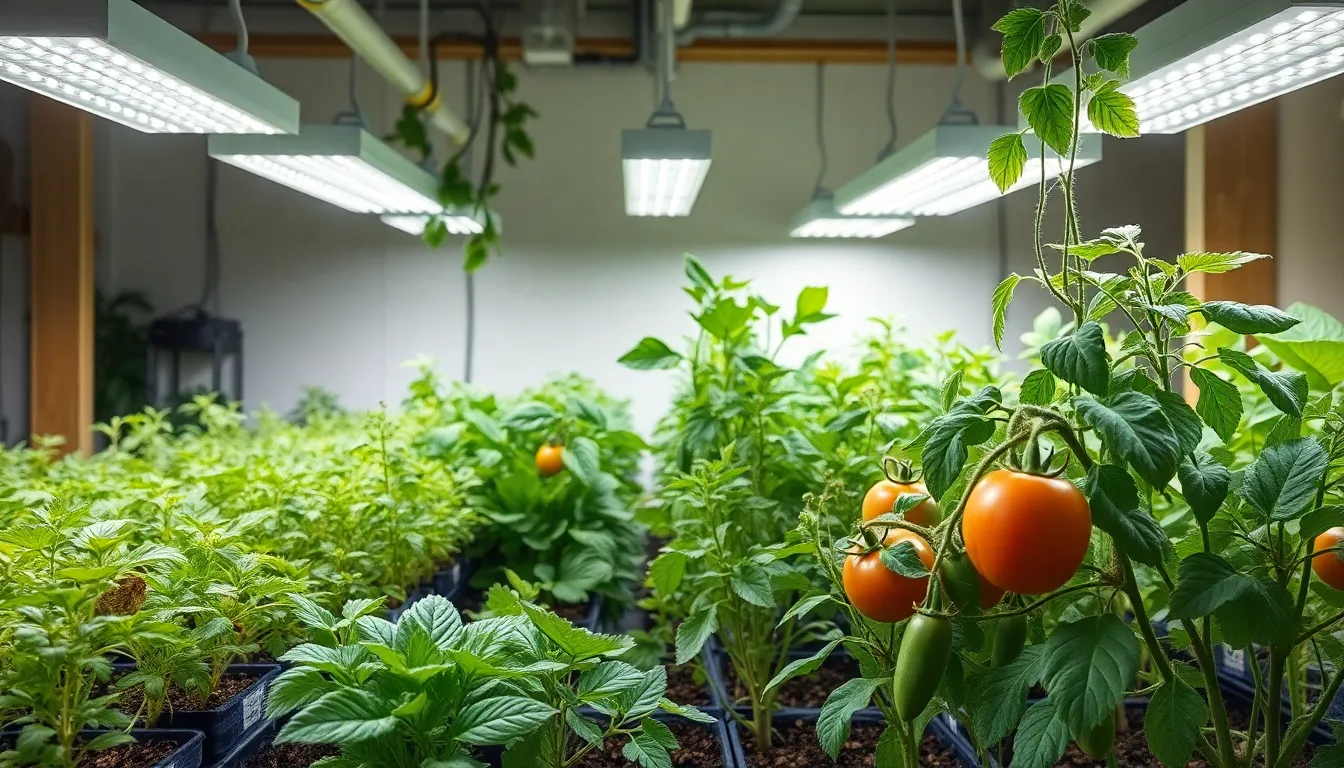
Now that we understand the basics of grow light technology and spectrum requirements, let’s jump into the precise measurements that’ll help you optimize your indoor garden’s performance.
Understanding PPFD and DLI Measurements
PPFD (Photosynthetic Photon Flux Density) measures the instantaneous light intensity hitting your plant’s surface, telling us exactly how many photons useful for photosynthesis reach each square meter per second. We measure this critical metric in μmol/m²/s, and it’s the foundation for determining whether your plants receive adequate light for healthy growth.
DLI (Daily Light Integral) takes PPFD measurements and aggregates them over a 24-hour period, giving us the total amount of photosynthetically active photons your plants receive daily. This measurement, expressed in mol/m²/day, helps us understand the cumulative light exposure that drives plant development.
Plants require different light intensities depending on their growth stage and species type. Most plants need a minimum PPFD of 400 μmol/m²/s for basic growth, while optimal photosynthetic absorption can reach up to 1200 μmol/m²/s for high-light demanding varieties.
Large warm-season vegetables like tomatoes and cucumbers thrive with a DLI between 20-30 mol/m²/day for maximum production. Leafy greens and herbs typically perform well with lower DLI requirements, while fruiting plants demand higher daily light integrals to support their energy-intensive flowering and fruit development processes.
Proper Distance and Positioning Guidelines
Distance between your grow lights and plants directly impacts light intensity and heat exposure, making proper positioning crucial for plant health. We recommend starting with lights positioned 12 to 36 inches above your plants, then adjusting based on plant response and growth stage requirements.
Vegetative growth stages typically allow for greater distances of 18-24 inches, providing adequate light while preventing heat stress during this critical development period. Plants focus on leaf and stem growth during this phase, requiring consistent but moderate light intensity.
Flowering stages often benefit from closer positioning at 12-18 inches, increasing light intensity to support the energy demands of flower and fruit production. This closer distance maximizes photon delivery when plants need it most for reproductive processes.
Seedlings require special attention with lights positioned 24-36 inches above the soil surface to prevent heat stress while encouraging strong, compact growth. Young plants are particularly sensitive to intense light and heat, making this conservative distance essential for healthy establishment.
Light positioning can vary dramatically from as close as 2 inches to as far as 2 feet, depending on your exact LED configuration and plant tolerance levels. Fine-tuning based on direct observation of plant response ensures optimal results for your unique growing conditions.
Coverage Area Requirements for Different Plant Types
Seedlings and small herbs thrive under evenly distributed, moderate-intensity light spread across smaller growing areas. These plants benefit from uniform PPFD distribution rather than intense hot spots that can cause stress or uneven development.
Large fruiting plants including tomatoes, cucumbers, eggplants, and peppers demand higher DLIs and broader coverage areas to support their extensive canopy development. These energy-hungry plants require consistent light penetration throughout their growing space to maximize yield potential.
Multiple T5HO light configurations can be strategically spaced to provide even coverage across growing trays, balancing light intensity with uniformity to eliminate dark zones. This approach ensures consistent plant development across your entire growing surface.
Proper coverage eliminates hot spots and shaded zones that create uneven growth patterns and reduced yields. Uniform PPFD distribution across your growing area maximizes photosynthetic efficiency and ensures all plants receive adequate light for optimal development.
Coverage planning should account for light penetration through plant canopies, especially for taller plants that may shade lower leaves. Strategic light placement and adequate coverage area prevent competition for light resources and promote healthy growth throughout your entire plant collection.
Selecting Grow Lights Based on Plant Categories
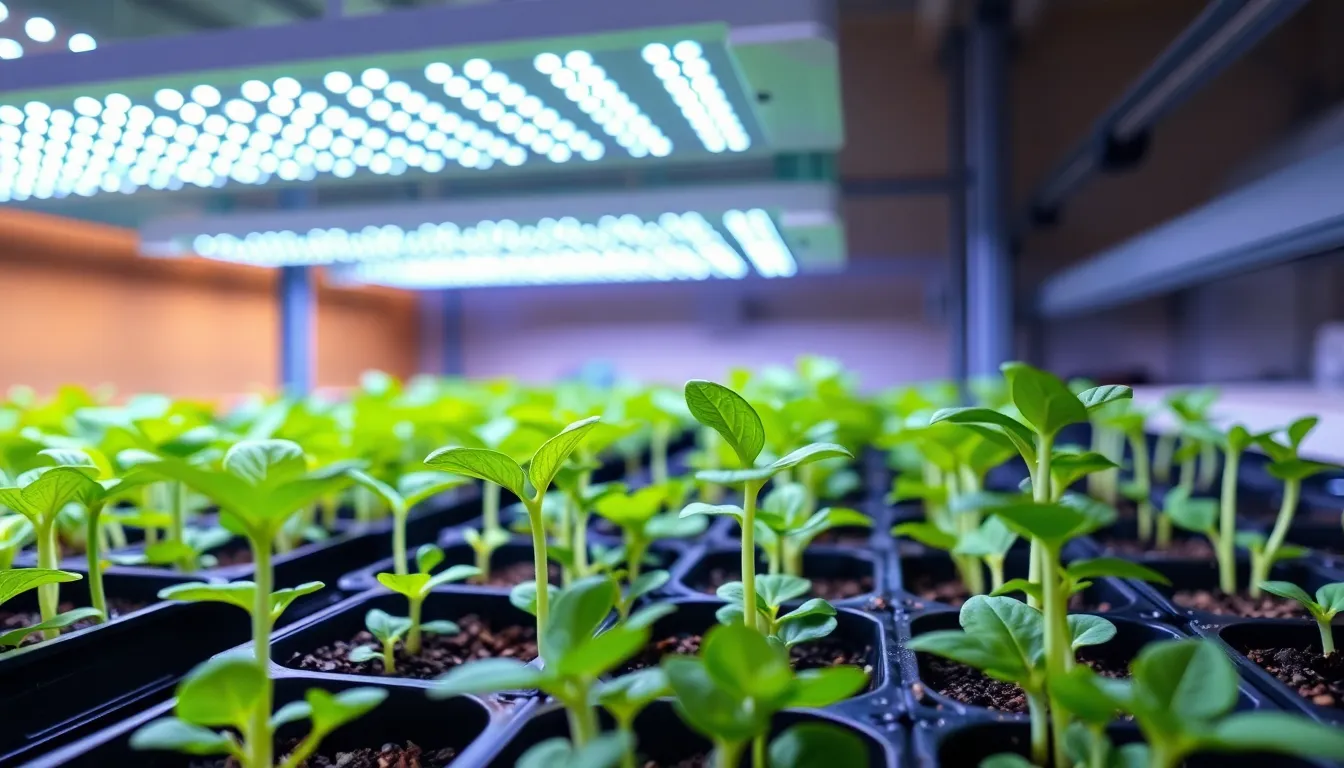
Different plants have unique lighting requirements that change throughout their growth cycle. We’ll examine the best grow light options for each plant category to help you make informed decisions.
Best Grow Lights for Seedlings and Propagation
Seedlings require exact lighting conditions to develop strong, healthy root systems and compact growth. Blue spectrum lighting promotes the short, stocky growth that’s essential for young plants during their most vulnerable stage.
Fluorescent lights work exceptionally well for propagation due to their wide spectrum coverage and minimal heat output. These lights provide gentle, consistent illumination without the risk of burning delicate seedling tissue. LED grow lights with strong blue components are becoming increasingly popular for seedling cultivation because they offer superior efficiency and precise spectrum control.
Young plants benefit from lights positioned 6-12 inches above the canopy to prevent stretching while encouraging robust development. Blue light wavelengths between 400-500nm help seedlings develop thick stems and dense leaf structure that will support healthy growth throughout their lifecycle.
Optimal Lighting for Leafy Greens and Herbs
Leafy greens and herbs thrive under balanced lighting that emphasizes blue wavelengths while incorporating red spectrum elements. Full spectrum LED lights provide the ideal solution for these plants because they deliver comprehensive wavelength coverage that supports vigorous foliage development.
Blue light maintains compact, nutritious leaves while supporting efficient photosynthesis in crops like lettuce, spinach, basil, and cilantro. Red light components help these plants develop robust flavor profiles and essential oil production that enhance their culinary value.
LED grow lights typically offer higher light output than fluorescent alternatives, making them suitable for achieving the moderate to high PPFD levels these plants require. Position lights 12-18 inches above leafy greens to ensure uniform coverage across your growing area while maintaining optimal light intensity for maximum yields.
High-Intensity Options for Flowering Plants
Flowering plants demand significantly more light intensity and exact spectrum combinations to trigger blooming and fruit development. Red spectrum lighting becomes crucial during flowering stages, as wavelengths between 660-730nm promote flower formation and fruit production.
High intensity discharge lights, including high pressure sodium and metal halide systems, have traditionally dominated flowering applications due to their powerful red light output. Modern high output LED grow lights now provide energy efficient alternatives with adjustable red and blue spectrum combinations that meet all flowering requirements safely.
Balanced red and blue spectrum combinations prevent the negative effects of excessive red light while maximizing flowering potential. Position high intensity lights 18-24 inches above flowering plants to deliver the 600-1000 PPFD levels these plants need for optimal bud development and fruit production.
Installing and Setting Up Your Grow Light System
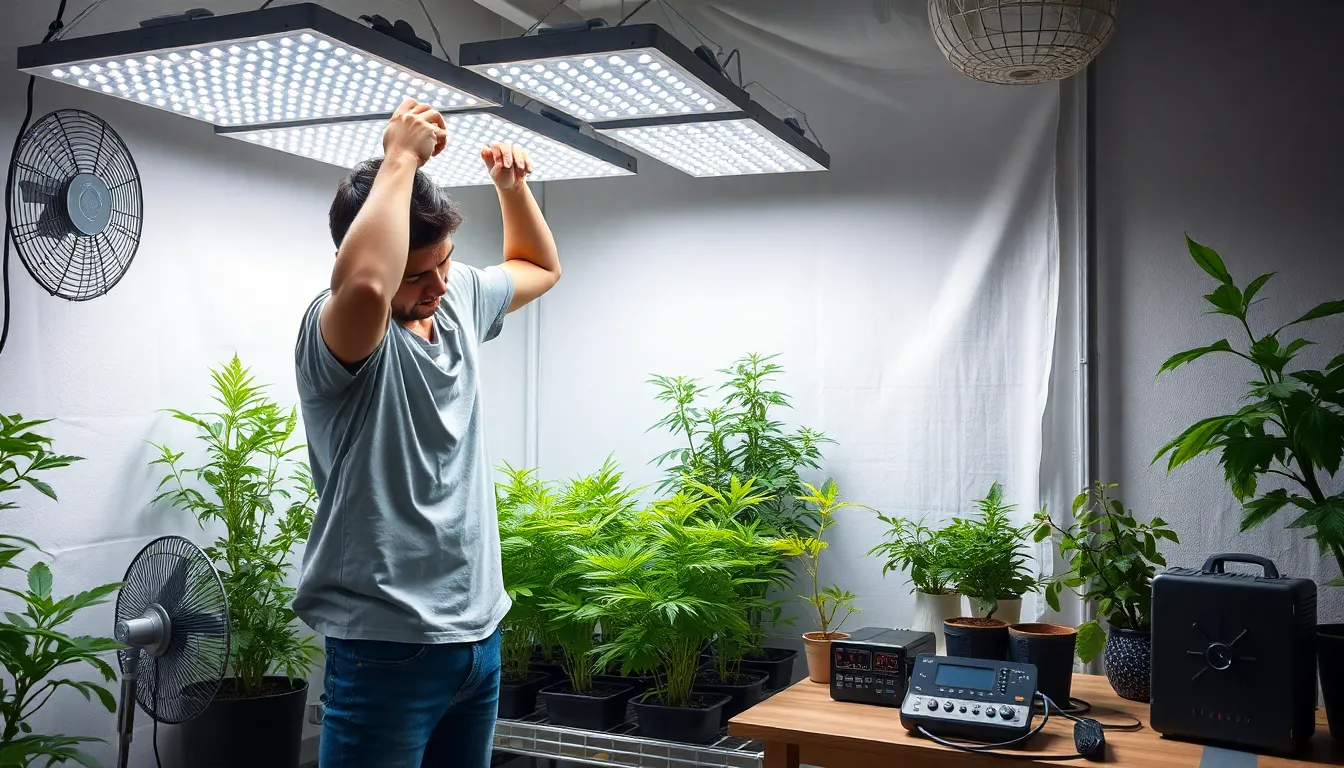
Proper installation and setup are crucial for maximizing the effectiveness of your grow light investment. We’ll walk you through the essential components that ensure your system operates safely and efficiently.
Mounting Options and Safety Considerations
We recommend positioning grow lights directly above your plants to simulate natural sunlight and provide even coverage across the entire canopy. Distance requirements vary significantly by light type: incandescent bulbs must be placed at least 24 inches above plants due to their high heat output, fluorescent lights work best at about 12 inches away, and LEDs can safely operate 6 to 12 inches from the canopy depending on their power output.
Ceiling and wall mounting using adjustable ropes or brackets offers the most flexible positioning options for your growing space. These systems allow you to raise or lower lights as plants develop, ensuring consistent coverage without wasting energy on areas beyond the plant canopy. Fixed mounting brackets work well for permanent setups, while pulley systems provide easy height adjustments for changing plant sizes.
Safety measures require securing all fixtures properly to prevent dangerous falls that could damage plants or cause injury. Electrical components must be rated for indoor use and protected from moisture exposure, especially in humid growing environments. Fire risk decreases significantly when you maintain proper distances between lights and plants, particularly with heat generating bulbs like incandescent options.
Timer Controls and Automation Features
Built in timer controls or compatible external timers automate your light cycles to maintain consistent growing conditions without daily manual adjustments. Plants typically require 12 to 16 hours of daily light exposure depending on their species and current growth stage, followed by at least 8 hours of darkness for proper energy metabolism.
Automated systems eliminate user error while providing precise photoperiod control that’s essential for healthy plant development. Digital timers offer programming flexibility for different light schedules throughout the week, while mechanical timers provide reliable basic on/off functionality. Smart home integration allows remote monitoring and adjustment of your lighting schedule through smartphone apps.
Ventilation and Heat Management Answers
Heat management becomes critical since certain grow lights generate important thermal output that can stress plants or damage equipment if not properly controlled. Incandescent and some fluorescent lights produce enough heat to require active cooling answers, while LED options generate minimal heat and can operate closer to plants safely.
Ventilation answers include exhaust fans, circulation fans, and dedicated air exchange systems that prevent heat buildup and maintain optimal growing temperatures. Strategic fan placement creates airflow patterns that eliminate hotspots while distributing heat evenly throughout your growing area. Proper air circulation also maintains ideal humidity levels that support healthy plant growth and prevent mold or pest problems.
Active cooling systems work best in larger operations where multiple high wattage lights create substantial heat loads. Passive cooling through proper spacing and lower heat output fixtures like LEDs offers energy efficient answers for smaller growing spaces.
Maximizing Energy Efficiency with Smart Grow Lighting

Smart grow lighting technology transforms energy consumption in indoor gardening through advanced features that optimize both plant growth and electricity usage. Modern LED systems deliver targeted wavelengths while minimizing waste, creating sustainable growing environments for serious cultivators.
Energy-Saving Features and Dimming Capabilities
LED grow lights excel at energy efficiency by emitting exact wavelengths that directly stimulate photosynthesis, eliminating wasted light and heat output. This focused emission increases plant growth efficiency while reducing energy consumption significantly compared to traditional horticultural lighting systems. Current driven technology allows fine adjustment of power usage, enabling dimming capabilities that reduce energy consumption during lower-light growth phases without compromising plant health.
Dimming features provide precise control over light intensity throughout different growth stages. Seedlings require less intense lighting than mature flowering plants, so we can reduce power consumption by 30-50% during early growth phases. Advanced LED controllers let us adjust individual spectrum channels, optimizing energy use while maintaining ideal growing conditions for each plant development stage.
Cost-Effective Operating Schedules
Strategic lighting schedules maximize energy utilization efficiency through precise timing and placement techniques. Purdue University research demonstrates that “close canopy” lighting strategies place LEDs closer to plants, increasing energy utilization efficiency by generating more biomass per kilowatt hour. Focused lighting approaches target only plant areas needing illumination rather than providing full coverage, reducing overall electricity consumption.
Automated scheduling systems allow us to program different light intensities for various times of day, matching plants’ natural photosynthetic cycles. Morning startup sequences gradually increase light intensity, while evening dimming phases prepare plants for rest periods. These optimized schedules minimize unnecessary energy expenditures during off-peak growth hours, lowering operating costs by up to 25% compared to constant full-intensity lighting.
Long-Term Investment Considerations
LED grow lights require higher upfront investment than traditional lighting options, but their longer lifespan and substantial energy savings contribute to lower total cost ownership. Studies show LED conversion reduces annual horticultural lighting electricity consumption by approximately 34%, translating to important cost savings of $350 million annually in the U.S. market while reducing carbon emissions.
| Investment Factor | LED Grow Lights | Traditional Lighting |
|---|---|---|
| Energy Reduction | Up to 40% | Baseline |
| Lifespan | 50,000+ hours | 10,000-15,000 hours |
| Heat Output | Minimal | High |
| Maintenance Costs | Low | High |
Consistent crop quality remains maintained or improved with LED systems, supporting their value as long-term investments. Lower heat emissions reduce cooling costs and create more stable growing environments. Energy consumption reductions of up to 40% have been reported across various growing operations, yielding substantial cost savings that typically recover initial investment costs within 2-3 years of operation.
Troubleshooting Common Grow Light Issues
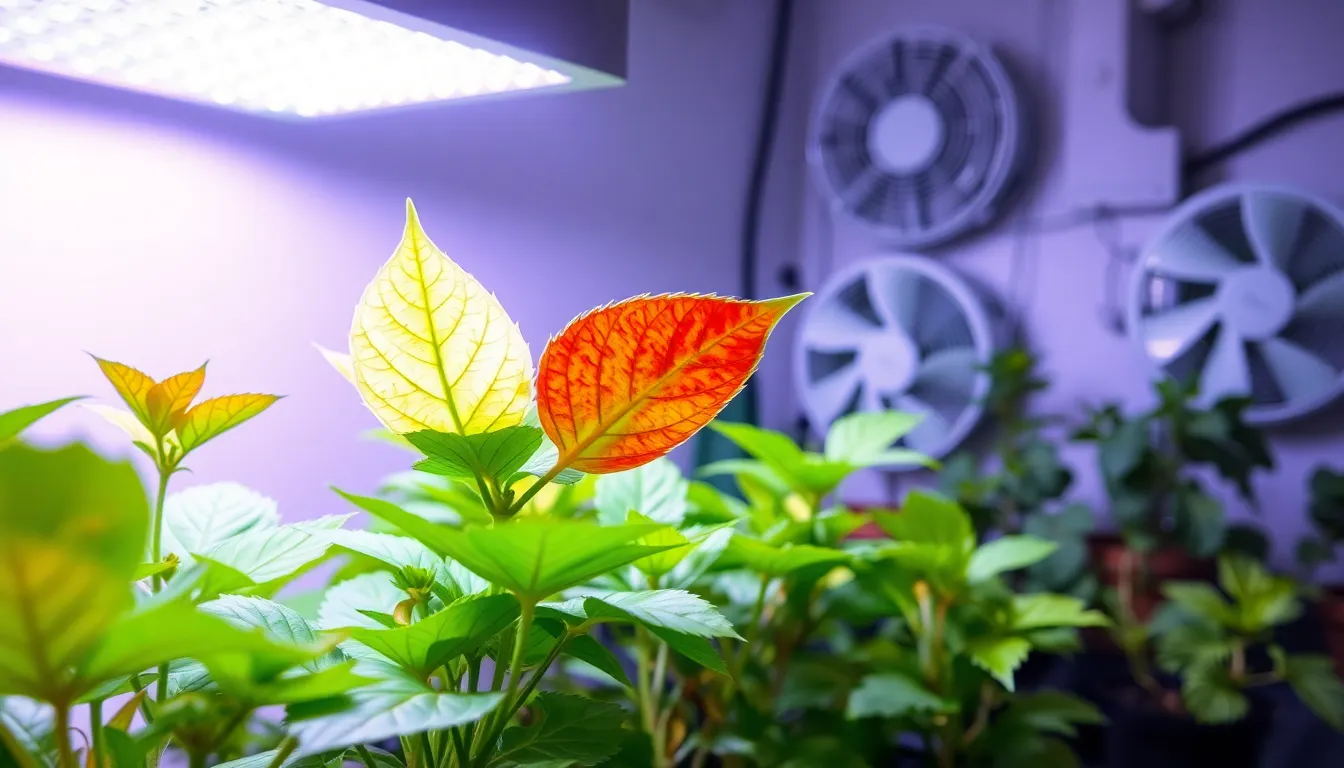
Even the most advanced grow light systems can encounter problems that affect plant health and growth. We’ll guide you through identifying and resolving the most common issues to keep your indoor garden thriving.
Identifying Signs of Light Burn or Deficiency
Light burn occurs when grow lights deliver too much intensity or sit too close to your plants, creating distinctive symptoms that we can easily recognize. Bleaching appears as the most obvious sign, where leaves lose their natural green color and turn pale yellow or white, particularly near the top of the plant closest to the light source. Bleached fruits and flowers reduce overall yield and indicate excessive light exposure that requires immediate attention.
Heat stress manifests differently from light burn, though both conditions often occur together under powerful grow lights. Leaves begin curling upward at the edges as plants attempt to conserve moisture, while the overall foliage appears wilted even though adequate watering. We notice that leaves become hard to pluck and remain attached to the plant even when severely damaged, unlike nutrient deficiencies where leaves typically fall off naturally.
Distinguishing between nutrient deficiency and light burn helps us apply the correct solution quickly. Nitrogen deficiency causes leaves to yellow and drop from bottom to top, while burned leaves stay attached but display discoloration and stiffness throughout the canopy. LED grow lights can cause these symptoms even without excessive heat, since their intense output can overwhelm plant tissues regardless of temperature.
Addressing Heat Problems and Plant Stress
Distance adjustment provides the most immediate solution when we observe signs of light burn or heat stress in our plants. Moving lights further from the canopy reduces both light intensity and heat exposure, allowing plants to recover while maintaining adequate photosynthesis levels. We typically increase the distance by 6 to 12 inches initially, then monitor plant response over several days.
Ventilation improvements help manage heat buildup that commonly occurs with HID grow lights and high powered LED systems. Installing exhaust fans removes hot air from the growing area, while intake fans bring in cooler fresh air to maintain optimal temperatures. We position fans to create gentle air movement across the plant canopy, which helps leaves release excess heat through transpiration.
Cooling systems become necessary in larger operations or when ambient temperatures exceed 85°F consistently. Portable air conditioners or evaporative coolers can maintain ideal growing conditions, particularly during summer months when heat stress occurs more frequently. We monitor root zone temperatures specifically, since overheated root systems can cause permanent damage even when foliage appears healthy.
Maintenance Tips for Optimal Performance
Regular cleaning prevents dust buildup that reduces light output and creates hot spots on LED fixtures. We clean diodes, drivers, and fixture frames monthly using soft microfiber cloths and compressed air to remove accumulated particles. Surge protectors require inspection every few months to ensure proper electrical protection for expensive grow light equipment.
Electrical connections need periodic checking to prevent flickering, dimming, or complete light failure that can stress plants and reduce yields. Loose connections generate heat and create fire hazards, so we tighten all terminals and inspect wiring during routine maintenance visits. Power supply units show signs of failure through inconsistent light output or unusual sounds that indicate replacement needs.
Component replacement becomes necessary when lights dim significantly or show uneven brightness across the fixture. We replace individual LED chips or entire power supplies when brightness drops below acceptable levels, typically after 30,000 to 50,000 hours of operation. Warranty coverage often applies to these replacements, making early detection of performance issues financially beneficial for our growing operations.
Top Brand Recommendations for Quality Grow Lights
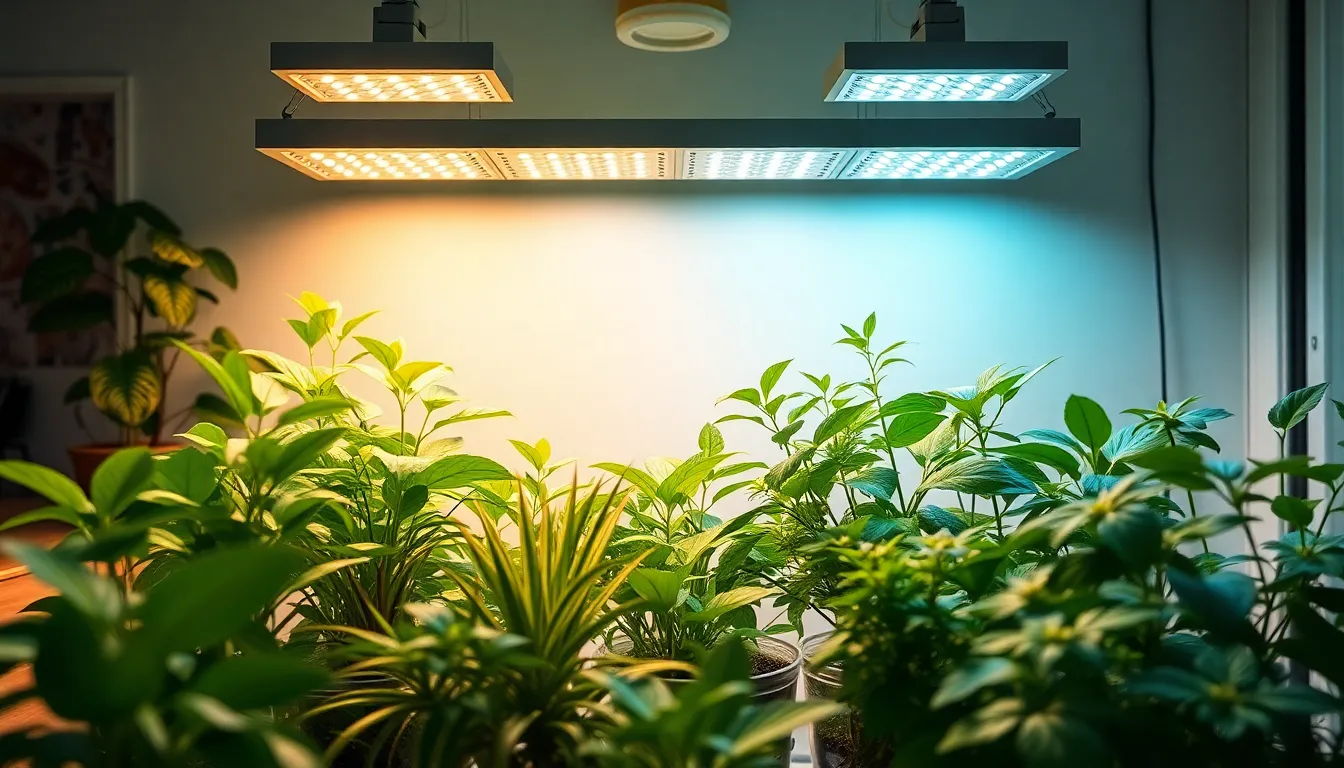
We’ve researched the top grow light manufacturers to help you make informed decisions for your indoor gardening success. Our recommendations focus on proven performance, reliability, and value across different price points.
Premium LED Grow Light Manufacturers
California Lightworks leads the premium grow light market with industry-leading full spectrum LED systems manufactured in the USA. Their MegaDrive series revolutionizes cost efficiency by eliminating individual drivers in LED fixtures, significantly improving your return on investment. The SolarSystem series features programmable digital spectrum control with power levels ranging from 200-800W, giving you complete control over your growing environment.
Horticulture Lighting Group (HLG) specializes in premium, high-end indoor gardening LED grow lights designed for both hobbyists and professionals. Their systems replace traditional HPS lighting while cutting electricity costs by 60% and improving growth quality. The HLG Tomahawk 720W LED grow light delivers full spectrum plus deep red coverage for 5’x5′ grow areas, making it perfect for serious growers seeking maximum yields.
Both manufacturers focus on energy savings and light spectrum customization to optimize plant health and yield. Their advanced light spectrum technology, high efficiency, and durability make them the top choices for growers who demand the best results.
Budget-Friendly Reliable Options
Mars Hydro stands out for balancing cost and performance with their high-efficiency full-spectrum LED grow lights backed by 14 years of research and production experience. Their systems are widely used by both beginners and experienced growers who want reliable performance without premium pricing. Mars Hydro provides efficient answers suitable for various indoor growing environments while maintaining quality standards.
Soltech offers a variety of affordable LED grow lamps for indoor plants, including the Vita Grow Bulb and Highland LED Track Light System. Their focus on versatility and quality lighting makes them ideal for small-scale indoor gardening projects. Soltech’s selection provides cost-effective options that don’t compromise on plant growth quality.
These budget-friendly options deliver reliable performance for growers who want quality results without the premium price tag.
Specialty Grow Lights for Exact Applications
California Lightworks offers programmable spectrum control that allows you to tailor light wavelengths for different plant stages including seedling, vegetative, and flowering phases. Their Optigrow light spectrum supports all growth phases, making it perfect for growers who want complete control over their plant development cycles.
HLG’s Tomahawk series includes deep red LEDs specifically designed to enhance flowering, making it ideal for growers focused on maximizing blooms and fruit production. This specialized spectrum combination targets the exact wavelengths plants need during their reproductive phase.
Soltech’s modular grow systems provide flexibility for varied indoor gardening setups, allowing you to customize your lighting configuration based on your exact space and plant requirements. Their modular approach makes it easy to expand or modify your setup as your growing needs change.
These specialty options ensure you can match your lighting system perfectly to your exact growing goals and plant requirements.
Conclusion
We’ve covered everything you need to know about choosing and using grow lights effectively for your indoor gardening success. From understanding light spectrums and PPFD requirements to selecting the right technology for your exact plants we’ve provided you with the knowledge to make informed decisions.
The investment in quality grow lights pays off through healthier plants faster growth and year-round harvests. Whether you’re starting with budget-friendly fluorescent options or investing in premium LED systems the key is matching your lighting choice to your plants’ exact needs and growth stages.
Remember that successful indoor growing combines proper lighting with good ventilation appropriate positioning and consistent maintenance. With the right setup and attention to detail you’ll create an optimal environment that rivals natural sunlight and supports thriving plants throughout every season.
Frequently Asked Questions
What are grow lights and how do they work?
Grow lights are artificial lighting systems that emit specific wavelengths of light essential for photosynthesis and plant development. They work by using LED chips, fluorescent tubes, or HID bulbs to produce photons at predetermined wavelengths, effectively replicating sunlight for indoor plants when natural light is insufficient.
Which type of grow light is most energy efficient?
LED grow lights are the most energy efficient option, consuming 30-50% less electricity than HID and fluorescent alternatives. They offer customizable spectrum control, longer lifespans, and can reduce operating costs by up to 25% when used with automated dimming and scheduling systems.
How far should I position grow lights from my plants?
Light positioning depends on the type: fluorescent lights should be 6-12 inches from seedlings, LED lights 12-18 inches from leafy greens and herbs, and high-intensity lights 18-24 inches from flowering plants. Adjustable mounting systems allow flexibility as plants grow.
What light spectrum do plants need for optimal growth?
Plants require different light spectrums for various growth stages. Blue light (400-500nm) promotes vegetative growth and strong roots, while red light (600-700nm) triggers flowering and fruiting. Full spectrum lights that mimic natural sunlight provide the best overall results throughout the plant lifecycle.
How do I know if my plants are getting too much or too little light?
Signs of too much light include leaf bleaching, heat stress, and burnt leaf edges. Too little light causes stretching, pale leaves, and slow growth. Monitor your plants closely and adjust light distance, intensity, or duration based on these visual cues.
Are expensive grow lights worth the investment?
Premium LED grow lights require higher upfront costs but offer significant long-term savings through energy efficiency, longer lifespans (50,000+ hours), and improved plant yields. The total cost of ownership is typically lower than cheaper alternatives over time, making them worthwhile investments.
What PPFD levels do different plants require?
PPFD requirements vary by plant type and growth stage. Seedlings need 200-400 μmol/m²/s, leafy greens require 300-600 μmol/m²/s, and flowering plants need 600-1000+ μmol/m²/s. Measure PPFD at canopy level to ensure your plants receive adequate light intensity.
How often should I clean and maintain my grow lights?
Clean grow lights monthly by gently wiping surfaces with a damp cloth to remove dust and debris that can reduce light output by up to 20%. Check electrical connections regularly, inspect for heat damage, and replace components as needed to maintain optimal performance and safety.

